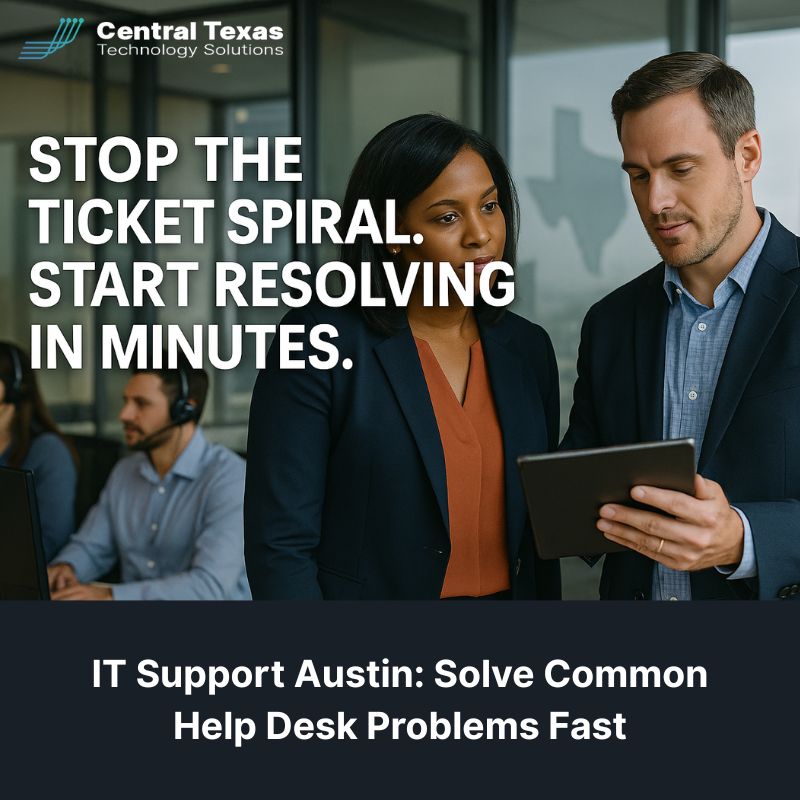
 In a growing Austin business, momentum is everything. Sales needs clean calls, finance needs live systems, and operations needs reliable apps. Then a login fails, Wi-Fi blinks, or a laptop starts crawling. Work stops, nerves spike, and confidence in support wobbles. Help desk problems rarely look strategic, yet the way you handle them shapes culture, delivery, and revenue.
In a growing Austin business, momentum is everything. Sales needs clean calls, finance needs live systems, and operations needs reliable apps. Then a login fails, Wi-Fi blinks, or a laptop starts crawling. Work stops, nerves spike, and confidence in support wobbles. Help desk problems rarely look strategic, yet the way you handle them shapes culture, delivery, and revenue.
Leaders do not need another list of technical tips. You need a simple plan that keeps people moving, lowers ticket volume, and turns support into a quiet strength. That is exactly what this guide delivers.
Why This Matters Now
Ignored help desk friction compounds. Tickets back up. Response times slip. Shadow IT appears. High performers find workarounds, then burn time coaching peers. Morale dips because people feel stuck. Clients feel the ripple when deadlines stretch.
You can change this with a few focused moves. The goal is not perfection. The goal is reliable resolution and steady prevention, so teams in Austin, Round Rock, Georgetown, and the I-35 corridor can focus on the work that wins customers.
How CTTS Guides the Fix
You do not need a new tool for every problem. You need a guide with a clear process and local accountability. CTTS serves Central Texas companies with a practical three-step plan.
-
Assess
We mine your last 90 days of tickets to find the real patterns. Lockouts. Printer queues. VPN drops. App crashes. We map first response time, time to resolve, and where tickets stall. -
Stabilize
We harden the basics. Clean device baselines, standard images, consistent patching, simple permission models, and network checks. We remove noisy alerts and automate the routine. -
Empower
We enable password self-service, build a short knowledge base that answers the top questions, and teach your team how to get help fast. We set SLAs that fit your business rhythm and publish them.
The result is fewer tickets, faster answers, and a support experience that feels calm.
The Usual Suspects and What Actually Works
You know the list. Here is how to handle it without drama.
Account and login issues
Give people a self-service password reset that works from phone or laptop, and require multi-factor for security. Publish a one-minute guide with clear screenshots. This alone can cut a large share of tickets.
Unstable Wi Fi or internet
Document a simple check path. User restart. Device network check. Office-wide check. Escalation. Keep a concise runbook for your internet provider and failover procedures. Consistency beats heroics.
Slow devices
Standardize device health. Minimum memory, clean startup, scheduled patch windows, and a monthly health report. Replace aging hardware on a predictable cycle so you never chase ghosts on a five year old laptop.
Apps that crash or will not update
Catalog your core apps and owners. Keep a clean install guide, supported versions, and a rollback step. When an update fails, people should know exactly where to look and who owns the fix.
Printers and peripherals
Keep drivers current, queues clean, and a single-page checklist at each device. Nothing wins goodwill like making printing boring.
Lost files
Turn on automated backups for documents and shared drives. Teach people where to find versions and restores. The best recovery is the one that does not require a ticket.
Security scares
Publish the rule. If it looks odd, stop and report. Give a single email and a single button to report suspicious messages. Celebrate people who report early. Quick isolation protects the whole company.
Five CEO-Level Moves That Raise Satisfaction Fast
-
Make the top ten answers one click away
Build a short, clear knowledge base that covers the questions you see every week. Login fixes. Wi-Fi steps. Printer reset. Email setup. Use plain language, numbered steps, and screenshots. Place it where people already work, like Teams or SharePoint. -
Give users real self-service
People should unlock accounts, reset passwords, and install common apps without waiting. Tie this to identity, not to devices. Every self-service success is one less ticket and one more moment of confidence. -
Set visible SLAs and honor them
Define severities, response times, and resolution targets that match your business. Publish them. Hold the team to them. When priorities are clear, queues move and frustration drops. -
Measure what moves the needle
Track first response time, time to resolve, tickets per employee, and the percentage solved by knowledge articles. Review trends monthly. Celebrate fewer repeats. Adjust where you see drag. -
Run proactive health as a habit
Patching, endpoint protection, disk space, and device age should never be surprises. A simple monthly health pass prevents far more tickets than another tool purchase.
What Success Looks Like in Central Texas
When the basics run clean, people notice. New hires onboard quickly. Projects stay on track. Leaders get fewer escalation emails. Clients feel steady delivery. Your support team stops chasing fires and starts improving the foundation. That is the shift from reactive to reliable.
Why Austin Companies Choose CTTS
We are local and invested. Our team lives and works in Austin, Round Rock, Georgetown, and the surrounding communities. We show up on site when it matters. We speak in plain language. We guide your leadership team through choices, then we do the work with your staff. You get a practical plan and visible results.
A Simple Next Step
If you want fewer tickets, faster resolution, and a support experience your people appreciate, let us map your first 90 days. We will review your ticket data, design a short list of fixes, and give you a clear plan with outcomes and owners.
Schedule a free strategy session with CTTS.
We will meet you where you are, make help desk support simple, and keep your team moving.
FAQ
What metrics should I review each month?
Start with first response time, time to resolve, tickets per employee, and the top five recurring issues. Add a short satisfaction survey for closed tickets.
Is outsourcing the help desk right for a smaller team?
Yes, if you value a predictable response, broader coverage, and a mature process. Many Central Texas firms with 20 to 75 staff see faster answers and lower risk with a managed model.
How quickly will we see improvement?
Most companies see quicker first responses in the first month, fewer repeat tickets in the second month, and a clear reduction in total volume by the end of the first quarter as the playbook takes hold.
Contact CTTS today for IT support and managed services in Austin, TX. Let us handle your IT so you can focus on growing your business. Visit CTTSonline.com or call us at (512) 388-5559 to get started!
